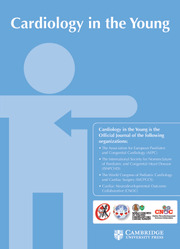No CrossRef data available.
Article contents
Transcatheter closure of multiple coronary to pulmonary artery fistulas in Fontan physiology using Amplatzer Vascular Plugs
Published online by Cambridge University Press: 10 October 2025
Abstract
Coronary to pulmonary artery fistula is a rare malformation that can be detected incidentally because most cases are asymptomatic. Here, we present multiple micro coronary to pulmonary artery fistulas in a Fontan physiology adult patient, which leaded dyspnoea due to elevated pulmonary artery pressure and were successfully closed with vascular plugs from the pulmonary side.
Information
- Type
- Case Report
- Information
- Copyright
- © The Author(s), 2025. Published by Cambridge University Press
References
Stout, KK, Daniels, CJ, Aboulhosn, JA et al. 2018 AHA/ACC guideline for the management of adults with congenital heart disease: a report of the American college of Cardiology/American heart association task force on clinical practice guidelines. Circulation 2019; 139: e698–e800.Google Scholar
Lim, JJ, Jung, JI, Lee, BY, Lee, HG. Prevalence and types of coronary artery fistulas detected with coronary CT angiography. AJR Am J Roentgenol 2014; 203: W237–W243
10.2214/AJR.13.11613CrossRefGoogle ScholarPubMed
Karazisi, C, Eriksson, P, Dellborg, M. Coronary artery fistulas: case series and literature review. Cardiology 2017; 136: 93–101.10.1159/000447445CrossRefGoogle ScholarPubMed
Grosse-Wortmann, L, Drolet, C, Dragulescu, A et al. Aortopulmonary collateral flow volume affects early postoperative outcome after Fontan completion: a multimodality study. J Thorac Cardiovasc Surg 2012; 144: 1329–1336.10.1016/j.jtcvs.2012.03.032CrossRefGoogle ScholarPubMed
Osawa, T, Schaeffer, T, Kristina, B et al. Impact of aortopulmonary collaterals on adverse events after total cavopulmonary connection. Eur J Cardiothorac Surg 2023; 64: ezad408.10.1093/ejcts/ezad408CrossRefGoogle ScholarPubMed
McElhinney, DB, Reddy, VM, Tworetzky, W et al. Incidence and implications of systemic to pulmonary collaterals after bidirectional cavopulmonary anastomosis. Ann Thorac Surg 2000; 69: 1222–1228.10.1016/S0003-4975(99)01088-7CrossRefGoogle ScholarPubMed
Bradley, SM, McCall, MM, Sistino, JJ, Radtke, WAK. Aortopulmonary collateral flow in the Fontan patient: does it matter? Ann Thorac Surg 2001; 72: 408–415.10.1016/S0003-4975(01)02813-2CrossRefGoogle ScholarPubMed
Kim, MS, Jung, JI, Chun, HJ. Coronary to pulmonary artery fistula: morphologic features at multidetector CT. Int J Cardiovasc Imaging 2010; 26 (
Suppl 2
): 273–280.10.1007/s10554-010-9711-3CrossRefGoogle ScholarPubMed
Liu, X, Zhang, L, Qi, Z, Fan, M, Ge, J. The characteristics of coronary-pulmonary artery fistulas and the effectivity of trans-catheter closure: a single center experience. J Thorac Dis 2019; 11: 2808–2815.10.21037/jtd.2019.06.60CrossRefGoogle ScholarPubMed


